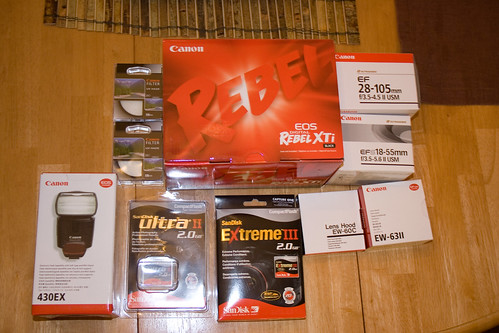Choosing the right Camera
By EricMesa
- 10 minutes read - 2036 wordsI often see many people asking online how to choose the right camera. They are bombarded with all the megapixels and various features on offer and they have no idea what to get. And usually the retailers (Best Buy, Frys, etc) try and get you to buy more camera than you need. So what should you buy? I’ll try and guide you with this blog post.
There are basically three types of digital cameras: point and shoot, prosumer, and dSLR. If you have never used a camera before, definitely go for point and shoot. Also, if you desire a compact camera you should get a point and shoot. If you have been using cameras for a while, but aren’t quite ready for a dSLR, you might want a prosumer camera. They tend to have more manual modes. Finally, if you are a pro, want to get into pro-level photography or are taking photography classes - get a dSLR.
Point and Shoot (typical price range $150s - $350s)
 This was taken with a Kodak DX3600, a point and shoot camera
This was taken with a Kodak DX3600, a point and shoot camera
The most important thing to know about point and shoot cameras is that they have very small image sensors for recording the photo. The smaller the sensor the worse quality the resulting image is. Why is this? The more packed together the photo-receptors are, the more they start interfering with each other. So you have a trade-off between how small your camera is and how good the resulting picture is. If you only view the pictures online, on your computer screen, and up to a 4x6 photo - you most likely won’t notice. The only thing you might notice is that the photos won’t be as sharp as some you see and the colours might not be as vibrant. Photography-wise it’s most important to have a camera you will take around and use to capture your life and express yourself through photos. So if you need a smaller camera that fits into your purse or pocket, choose that - the difference in fidelity isn’t large enough to keep you from using the camera because it’s too bulky.
[caption id=“attachment_2091” align=“alignright” width=“160” caption=““remnants” by jecate on flickr - a really good example of what you can accomplish with a point and shoot camera (Casio EX-Z1080)”] 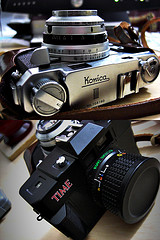 [/caption]
[/caption]
The next most important thing to know is that megapixels aren’t as important as the retailers would have you believe. When I had a 2.3 megapixel Kodak camera I was able to make prints up to 8x10 inches and viewed from the the normal distance it looked perfect. So unless you plan to make enlargements up beyond 8x10, anything you buy nowadays will have enough megapixels. On top of that, if you have too many megapixels in a small sensor, it’s not as sharp as it could be. So choose based on features, not megapixels.
Another important thing to consider with point and shoot cameras has to do with the viewfinder. First of all, many budget point and shoot cameras don’t even have a viewfinder anymore. So if you’re used to the old style and prefer it, you may need to watch out for that (especially if you buy online where you might not be able to see it from all angles). Also, the screen on the back of the camera uses up a lot more battery power than not using it or only using it to review photos. So if you primarily use the viewfinder to aim your shots, you won’t have to change the batteries as often. Finally, holding the camera out at arms length to use the screen for aiming results in a greater likelihood of camera shake as that position is not as steady. However, it is important to know that the viewfinder is offset from the lens. When you’re shooting your friends a few feet away it doesn’t matter, but when you get close, it can make a difference. And that’s where it helps to have the screen on the back.
Prosumer (typical price range $400s - $800s)
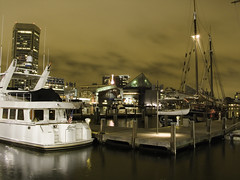 Taken with the prosumer Fujifilm Finepix S7000
Taken with the prosumer Fujifilm Finepix S7000
A prosumer camera is [almost] always larger than a point and shoot camera and some may be as large as a dSLR body (with the lens area typically being smaller). Since they are larger in size they will usually have a larger image sensor and, therefore, be able to take better pictures, than a point and shoot. Some models have a screen inside the viewfinder like in a video camera so you can see what the camera will take a picture of (getting rid of that problem we spoke of at the end of the last section). Also, since they usually cost more than a point and shoot, they usually have a lot more features. One of the key features of a prosumer camera is that it tends to have the ability to use more advanced photography features such as control over ISO, f stop and shutter speed. Most point and shoot cameras, on the other hand, are fully automatic with only some of the most expensive models allowing control over those features.
The ability to control the shutter speed and f stop will allow you to grow in your photographic skills. With a point and shoot you are letting the camera make all the key decisions for you. With a prosumer camera you can explore photography. The ability to change the f stop allows you to control how much of your photo is in focus. You can pick a large aperture like f/2.8 and throw everything but your main subject out of focus. Or you can stop down to f/16 and have everything in focus from front to back. You can have a slow shutter speed and blur your subject to convey movement or a fast one to freeze him in the air as he does an awesome bicycle trick. Being able to open up your shutter for a long time you let you get a picture like the one in this section of Balitmore’s Inner Harbor at night.
So when you’re ready to take your photography to the next level, you might consider a prosumer camera. It will give you a taste of what it’s like to do things manually before you spend the significant investment that a dSLR can be. Just consider the negative that it will be bulkier and heavier than a point and shoot. You may decide, like I did, to have a point and shoot for when you need a camera that can fit in your pocket and a prosumer for those special moments.
dSLR (typical price range $800 - $8 000 for body only)
The dSLR is the ultimate level in portable photography. It is a lot more expensive than a point and shoot or a prosumer because the lenses come separate from the body. Sure, if you buy your kit at Costco or B&H Photo and Video you might be able to buy it in a kit with a lens, but you will need more than just the kit lens if you are serious about photography. So don’t just get a Canon or Nikon dSLR just because you see everyone with one nowdays (I know I do!). As you can see from the previous sections, you can still get great shots with a point and shoot or prosumer camera. The only reason my dSLR pictures are generally better than my point and shoot and prosumer shots is that I have been improving in my photography as time has gone by. But if you go into any flickr group devoted to prosumer and point and shoot cameras you’ll see tons of amazing shots.
[caption id="" align=“alignright” width=“240” caption=“Just a very small sample of the many lenses you can end up buying for your dSLR.”]  [/caption]
[/caption]
As I mentioned before, with dSLR cameras you have to buy the lenses separately. And you get what you pay for. Good glass (as it’s called) costs a lot of money. Here’s an example. With Canon there is a set of lenses at the 50mm focal range. The cheapest one is $89. The next best quality one is $300. And the best quality 50mm lens Canon makes costs $1200. Now, it’s not that you can’t take good or even great pictures with the $89 lens. But many features will be better with the more expensive ones. For example, they may focus faster, produce sharper pictures, or be constructed of better materials. Getting the best (or even just great) quality lenses to cover all the standard focal lengths can run into the thousands of dollars. Additionally, with some of the more professional cameras you have to buy the flash separately. Again, this is about giving the photographer the ultimate in choice. Unlike a lower end camera, you choose how powerful of a flash you need and what features it should posses.
Now, there is a benefit to having to buy your lenses - you have better control of the range of focal lengths for your camera. With your prosumer or point and shoot camera you have a maximum telephoto range. For example, something 12 feet away can fill the whole frame. A dSLR 600mm lens might allow you to fill the frame with a bird in flight dozens of feet away. Of course, the lens itself will cost over $2k, but if you are passionate about avian photography or can make a living off of it - it might be worth the money.
[caption id="" align=“alignleft” width=“240” caption=“The Canon EOS 350D and the author”] 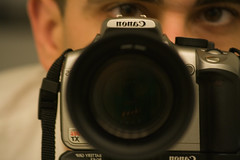 [/caption]
[/caption]
dSLR cameras have the largest sensors in this group. With the Canon system there are three ranges - the xxxD (350D, 400D, etc) cameras have APS-C sensors. They are much larger than a point and shoot camera but smaller than 35mm film. This also extend to the xxD (40D, 50D, etc) cameras. The 1D has a larger APS-H sensor. The 5D and 1Ds have 35mm film-size sensors, providing the best quality shots. With the right lens and conditions on a camera with a full frame sensor, as these are referred to, the resulting photo has the most vibrant colours and the sharpest focus your money can buy. If you are going into photography professionally or are just serious enough about photography to plunk down $2.8k (for the 5D) or $8k (for the 1Ds), you will get the best shots you can get with a dSLR camera. Only a medium format camera (which is very large and practically impossible to carry around) can get better shots.
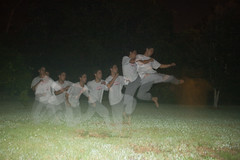 With a dSLR and the proper flash equipment you can get shots like this
With a dSLR and the proper flash equipment you can get shots like this
One final important note when it comes to dSLRs is that as a general rule you cannot mix and match lenses from different companies. So it is important to do your research before you select a Nikon, Canon, Sony, or Olympus dSLR. Once you start investing money into serious glass, it will be a very expensive mistake if you suddenly realize you like Canon better than Nikon or vice versa. From the people I have spoken to, this is a very personal choice. Don’t just go with what your friend or friends have. Go to a store where you can handle the camera and get a feel for whether it meets your needs. Or, see if you can rent or borrow one from a friend and try and get some shots and see if you like the quality of the photos, the build construction, the lens handling, etc.
I hope that was pretty informative and you can now reach beyond the hype and buy the right camera for your needs. If you are completely new to photography I suggest taking the route I took and moving from point and shoot to prosumer to dSLR. That way you don’t realize you hate photography after having spent all that money. Also you won’t have to feel overwhelmed by all of the manual options on the better cameras (as some people complain about online)
[caption id="" align=“aligncenter” width=“500” caption=“Taken at Cony Island in Brooklyn, NY with a Canon EOS 400D”] 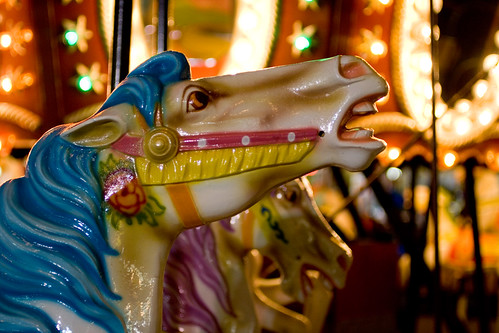 [/caption]
[/caption]
